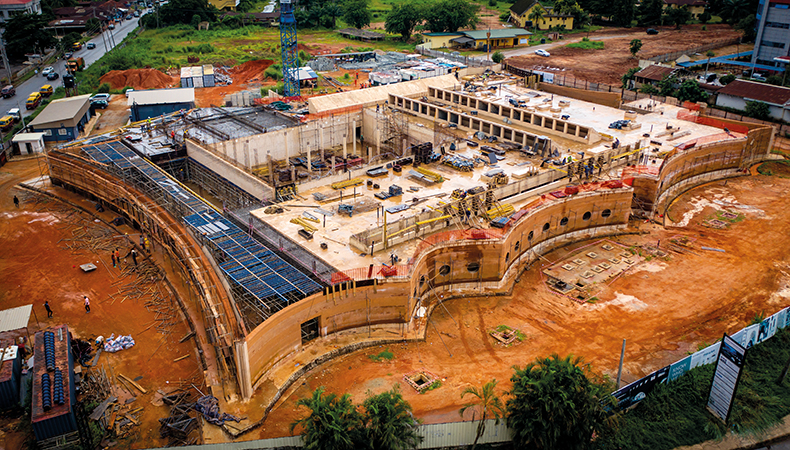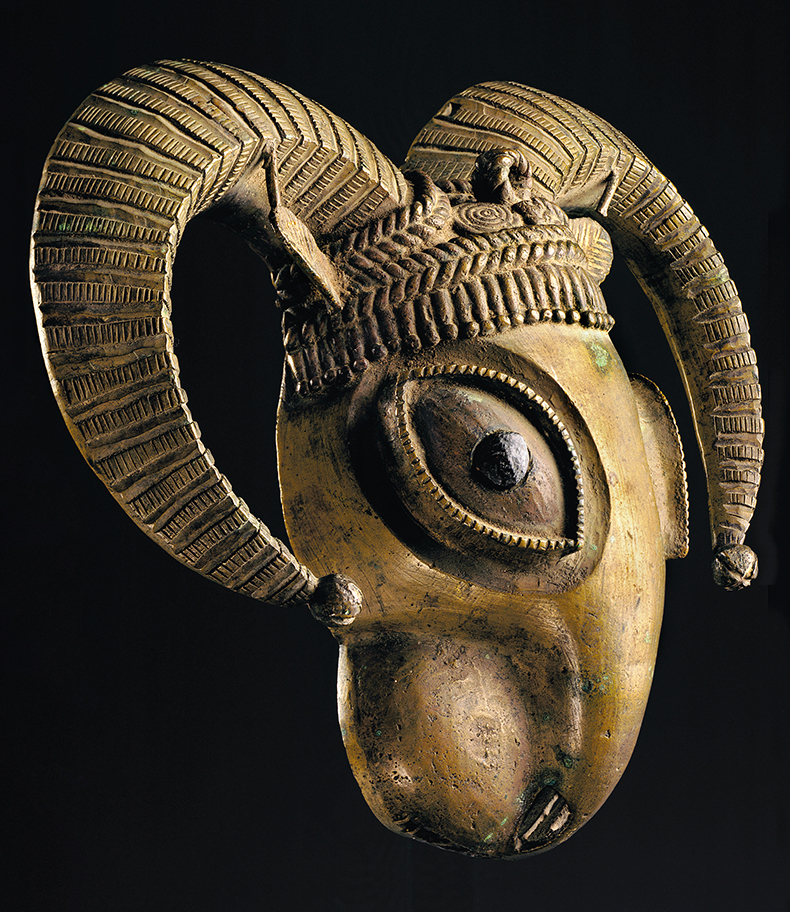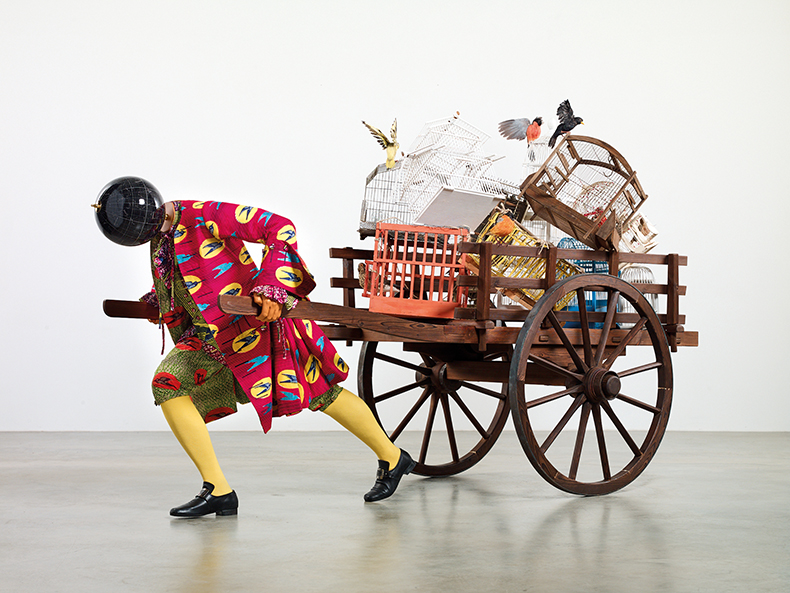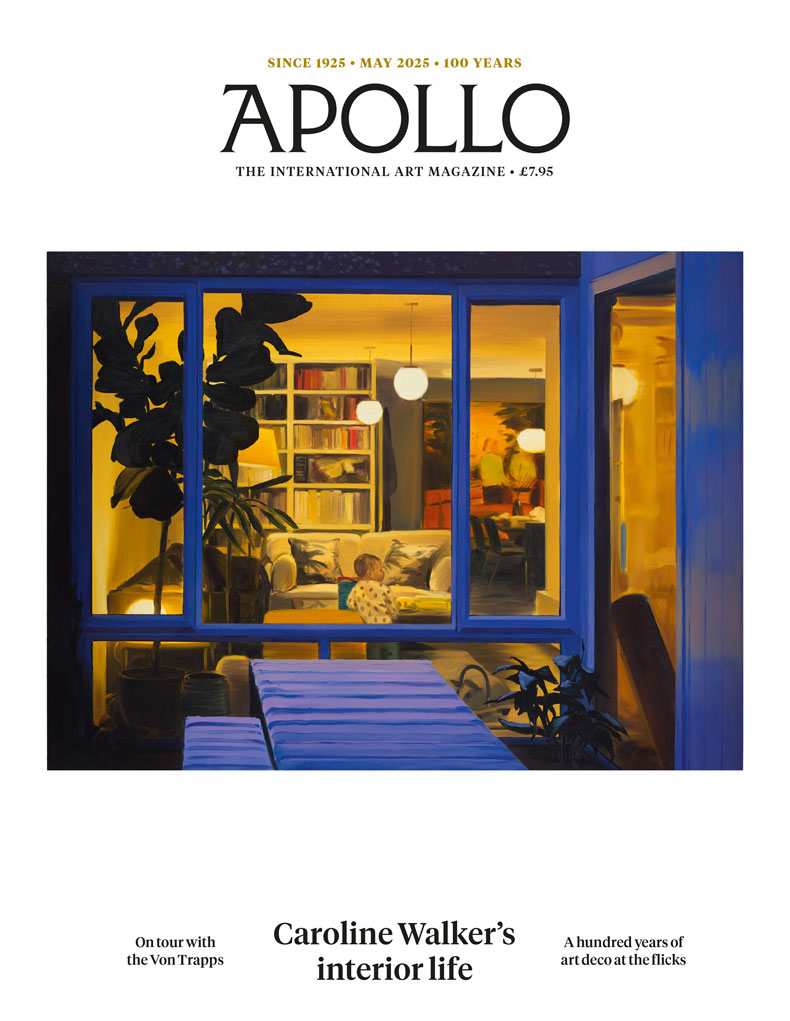From the July/August 2024 issue of Apollo. Preview and subscribe here.
‘We are completely unencumbered,’ Phillip Ihenacho tells me. Ihenacho is the director and chairman of the Museum of West African Art (MOWAA), which is due to open the first building of its campus, the MOWAA Institute, in Benin City, Nigeria, on 4 November. He is reflecting on the prospect, at once ‘terrifying’ and ‘inspiring’, of preparing to launch a museum with huge ambition, but no collection.
Perhaps there is a degree to which Ihenacho is making virtue of necessity. When the plans were first announced in 2020, the museum was closely linked with the projected return of Benin Bronzes from European collections, looted during the British punitive expedition of 1897. Since then, a complex and often fractious tussle to determine the rightful recipient of any restituted Bronzes – whether the traditional king of the Edo (the Oba), the National Commission for Museums and Monuments (NCMM), or the Legacy Restoration Trust (now the MOWAA trust) established by the outgoing Edo State governor Godwin Obaseki – has been rumbling on. ‘We felt that we should try and remove ourselves as much as possible from the discussion around the return of the Bronzes,’ Ihenacho says. As a result, with the first phase of its opening drawing near, the museum has begun to establish itself at the heart of a rather different but no less urgent discussion. How could, or should, a West African museum define itself in the 21st century?
Instead of acting as custodians of cultural property, MOWAA now sees its remit as democratising access to the rich heritage that already exists in Nigeria, both material and intangible. When it is complete, the campus – designed by Adjaye Associates, one of the briefs the firm has held on to since allegations of sexual assault (which David Adjaye denies) were made in 2023 – will comprise a Rainforest Gallery, with 1,400sqm of exhibition space; an Artisans Hall, where local craftspeople can sell their wares; a guesthouse for visiting artists and academics; a material science lab and a group of memorial gardens and sculpture parks that link the historic site within the ancient walls of Benin City to the surrounding forest.
Regeneration is the name of the game, and the term – as with everything MOWAA is proposing to do – demands to be considered broadly. It encompasses efforts to reconnect local artisanal practices with both historical treasures and contemporary West African artists who have made their name in the global art world. It spans local reforestation projects and the pre-construction archaeological work that has been carried out on its site, in collaboration with the NCMM, the British Museum, Cambridge Archaeological Unit (CAU) and Wessex Archaeology – the first significant excavations of Benin City to have occurred since Graham Connah’s digs in the 1960s. Extensive new three-dimensional mapping using drone imagery is underway, in partnership with the German Archaeological Institute, of the hundreds of kilometres of defensive moats that once defined the city, before the fires that ravaged it in the wake of the punitive expedition. And there are concerted efforts to include local Edo communities in the process – not considering oral tradition as a source of secondary importance to the science, as has been matter of course in the past, but treating its repositories as active partners in the exchange and management of knowledge. MOWAA was, until last year, known as EMOWAA, but it has dropped the ‘Edo’ from its name – partly, as Ihenacho tells me, to play down its associations with the Edo State government, but also to emphasise that the museum’s remit goes far beyond its ancestral home, contextualising the culture of Benin within the broader region of West Africa.
The Institute, its director Ore Disu tells me, is to be the ‘brain box’ of all this. A rammed-earth building, reminiscent of the city’s pre-colonial architecture, it will have at its heart a 700sqm open-storage space, where visitors can observe conservation of objects (including archaeological finds from the site) first-hand. There is to be a Digital Lab, whose projects in the coming years include a virtual collection of West African artefacts, a public access digital heritage library that focuses on the medieval history of West Africa, and the full digital mapping of ancient Benin. There will also be, Disu says, ‘dedicated, specialised rooms for both historical art and antiquities, and contemporary art’.

The MOWAA site under construction; its walls are made of locally sourced rammed earth. Courtesy Museum of West African Art (MOWAA)
But where, if not from MOWAA’s own collection, is all this art going to come from? There are, I am told, discussions regarding loan partnerships with international museums – confidentiality agreements forbid anything more specific at this time, though it’s worth noting that advisory support has been provided by the British Museum, the Met, and the Whitney. But the core partnership is closer to home.
‘The irony with the discussion around restitution,’ Ihenacho tells me, ‘is that West Africa is not short of objects.’ Innumerable thousands of them are held in the prodigious collections of the NCMM, which oversees 52 museums, 10 libraries and 65 monuments across the length and breadth of Nigeria. Most, however, are in poor repair, the treasures of Nigeria’s past languishing in inhospitable storerooms, without temperature controls – or staff with sufficient training – to protect them. Rectifying this has long been low on the political agenda, due to a prevailing attitude that Ihenacho describes as: ‘Nigeria has so many critical issues in education, in health care. Why would you spend money showcasing some old objects?’
However, the other reason that, for decades, there has been so little political will to support this institution is its unshakeable colonial baggage – and it is this that makes MOWAA’s establishment of intimate ties with the NCMM, as it attempts to move past inherited ideas of what a museum is and does, so intriguing. The crumbling buildings at Jos, Ife or Lagos – and the collections they house – are tangible reminders of the fact that the British Empire did not just weaken the old ways of preserving cultural memory in Nigeria, most notoriously through the plunder and desecration of the Oba’s palace in 1897. It also dictated the procedures for safeguarding material heritage that were established in their stead.
The progenitor of the NCMM, the Nigerian Antiquities Service, was founded in 1943 – but its origins can perhaps be pinpointed to 14 December 1927, when the 25-year-old Kenneth Crosswaithe Murray arrived in Lagos. The grandson of Sir James Murray, founding editor of the Oxford English Dictionary, Murray was selected by Eric Swanston, then deputy director of the Education Department, as the colonial government’s first official arts and crafts teacher, with a remit to advise on the impact of Western-style education on Nigerian art. He immersed himself in the project of revitalising Nigerian crafts – and identified very early that the lack of any institutional collection of historical Nigerian art objects, or any museums in which to house such a collection, was a serious impediment to these efforts.
In 1935, he began actively acquiring a personal collection of Nigerian art; the following year, he was sent with Arthur Hunt-Cooke, then Surveyor of Education and an anthropologist by training, to study Yoruba crafts in the cities of Ibadan and Abeokuta, and mentioned in a letter home to his mother the need for a museum in Nigeria to ensure the preservation and public availability of such objects. By 1941, his personal collection numbered more than 200 art objects, principally woodcarvings and terracottas, which he sent to South Africa for safekeeping during the Second World War. In the meantime, he had continued to publicise the products of his education programme in both Nigeria and Britain – including, in 1937, through his hugely popular presentation of work at the Zwemmer Gallery in London by protégés such as Ben Enwonwu.

Ram’s head, 15th century, Owo, Nigeria. National Museum of Lagos. Photo: Andrea Jemolo
In the years between the inauguration of the Nigerian Antiquities Service on 28 July 1943, with Murray as first director, and the advent of Nigerian independence on 1 October 1960, seven national museums opened in Nigeria. The first – indeed, the first Western-type museum in West Africa – was the Jos Museum, opened under the directorship of Bernard Fagg in 1952, principally to exhibit the ancient terracotta heads of the Nok civilisation; Fagg had been instrumental in the discovery and excavation of these from the Jos Plateau in 1944. It was followed by the Ife Museum in 1954, and the National Museum, Lagos, in 1957, which Murray saw as his crowning achievement. After he died, in a road accident between Ijebu and Benin on 21 April 1972, a special memorial issue of African Arts journal was devoted to fond reminiscences of Murray ‘through the eyes of his friends’. These included J.D. Clark, who wrote that ‘In the 1920s most Nigerians were primarily interested in acquiring European culture: the arts and crafts of their parents were despised as “uncivilised”; and few Europeans were concerned about the conservation of art. Kenneth Murray faced this hostility and apathy for years, steadily dispelling it.’
Clark’s words are a textbook example of what Chika Okeke-Agulu, a professor of art history at Princeton and senior advisor to MOWAA, describes to me as ‘salvage paradigm’. ‘These ethnographic museums,’ Okeke-Agulu tells me, ‘were imagined as holding places for supposedly lost and dying African cultural and artistic traditions. Houses of dead things.’ The antiquities service was reimagined in the postcolonial era, most particularly under the influential directorship of Ekpo Eyo in 1968–86, who brought new sites under its remit, achieved global exposure for its collections with the touring exhibition ‘Treasures of Ancient Nigeria’ (1980–83) and oversaw its dissolution into the NCMM in 1979 – but the core of its collection was established during the Murray years, with Bernard Fagg and his more famous brother, William Buller Fagg, the long-serving keeper of ethnography at the British Museum, playing a key role. ‘Much of what has been collected and stored in Nigeria,’ says the writer Lucky Igohosa Ugbudian, ‘was not decided by the people of Nigeria.’ A crucial question facing MOWAA, in its foundational years, is going to be the way that it navigates this legacy.
Perhaps the most impressive aspect of the museum in this regard is its aversion to throwing the baby out with the bathwater. This means not getting bogged down in the colonial ideologies that shaped the collections of the NCMM, but treating them as a resource and choosing what to take from them. Disu tells me that the ‘staples’ of Nigerian art history will be covered – the terracottas of the Nok civilisation (1500 BC–1 BC); the bronzes of the Ife Empire (1200–1420); Benin, of course. ‘But it’s also important for us to look at other spaces of craftsmanship. Areas that are known for creativity, but not necessarily political power in the same way as those civilisations were known – communities that might have focused more on woodwork [of which very few examples from before the 18th century survive] or might have been major centres for trade.’ In time, once the expensive business of completing the building is over, the museum will look to establish its own acquisitions programme.
The museum’s vision of revitalising artisanal crafts (the word ‘traditional’ is abjured) by reconnecting them with the example of historical artefacts carries echoes of Murray’s project – but it has been thought through in a more holistic and less prescriptive way. Murray and his contemporaries decried and sought to quell what they saw as the corrupting influence of African artists who engaged with European aesthetic principles – Renaissance perspective, for instance. Here, as curator of modern and contemporary art at MOWAA Aindrea Emelife tells me, the museum’s ‘vast remit’ is to take ‘the historical right up to the contemporary’; she suggests plans for residencies that pair local bronze casters, perhaps from the historic guild that still operates on Igun Street in Benin City as it has done for centuries, with West African artists who might instead fall under the umbrella of ‘global contemporary’. And MOWAA is to be a museum that upholds international ‘standards’ – Disu’s word – for conservation, research and digital innovation, but which also maintains a commitment to local understanding of culture.
There have been other efforts in recent years to rethink what a museum might mean in an African context – Nana Oforiatta Ayim’s Mobile Museum in Ghana, the work of Sylvain Djache Nzefa with the Route des Chefferies in Cameroon, the state-funded Museum of Black Civilisations in Dakar or, in Lagos, the John Randle Centre for Yoruba Culture & History. But none has secured MOWAA’s vast international nexus of support. From this vantage point, still a few months from the launch, it is hard to disagree with Okeke-Agulu when he tells me that ‘considering its scale, complexity, ambition, MOWAA is an unprecedented addition to this mix.’ I want to call MOWAA a marriage of epistemologies – but I’m mindful of Disu’s injunction that the museum describe its practices in ‘typical, day-to-day expression’: ‘how we keep objects’ rather than ‘conservation’, for instance. So perhaps it’s better to say that the museum is intended to be a place where different ways of understanding and interpreting the past, present and future can meet on an equal footing – a place that doesn’t just celebrate West African creativity, but generates the conditions in which it can continue to thrive.

The Bird Catcher’s Dilemma (2019–20), Yinka Shonibare. Salzburg Museum. Photo: Stephen White & Co.; courtesy the artist/Stephen Friedman Gallery, London and New York; © the artist
The Museum of West African Art (MOWAA) is due to open on 4 November.
From the July/August 2024 issue of Apollo. Preview and subscribe here.
Monday 18 November: a previous version of this article claimed that MOWAA is ‘one of few major briefs the firm [Adjaye Associates] has held on to since allegations of sexual assault’. At the request of Adjaye Associates, we have amended this to reflect the fact that the firm only lost some of its briefs due to these allegations and is currently working on 11 major projects.














![Masterpiece [Re]discovery 2022. Photo: Ben Fisher Photography, courtesy of Masterpiece London](http://zephr.apollo-magazine.com/wp-content/uploads/2022/07/MPL2022_4263.jpg)
Why it’s time to stop rediscovering Eileen Gray